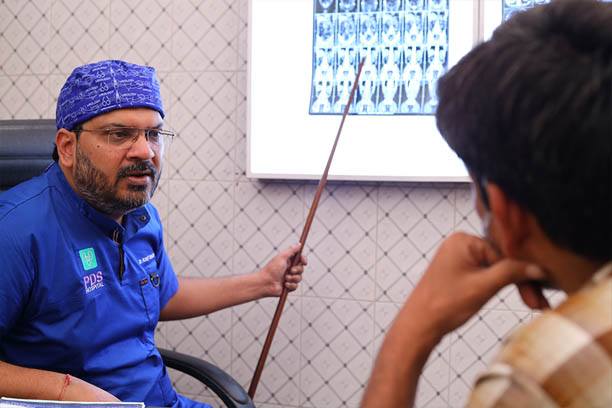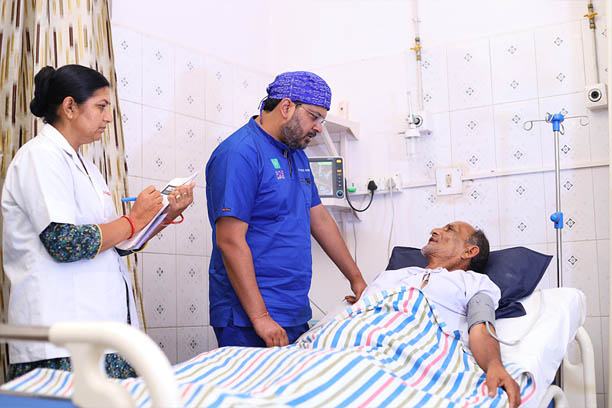Prostate Type, Surgery and Treatment in Pilibhit
- Home
- Departments
- Urology
- Prostate
Prostate
The prostate is a gland in men. It helps make semen, the fluid that contains sperm.
The prostate is a gland of about the size of a small walnut, and it constitutes a component of the male reproductive system. Its primary role is to generate seminal fluid, a significant constituent of ejaculate. This fluid contains substances that aid in liquefying the ejaculate, thereby assisting sperm in reaching the female reproductive tract.
Additionally, the prostate surrounds the urethra, the tube responsible for transporting both urine from the bladder and semen from the reproductive organs.
The smooth functioning of the prostate is essential for proper urinary and reproductive processes. However, as men age, the prostate can sometimes enlarge, a condition known as benign prostatic hyperplasia (BPH), which can lead to urinary difficulties. Furthermore, prostate-related conditions, such as prostate cancer, can also arise, underscoring the importance of regular medical check-ups for maintaining overall male health.
Prostate Surgery (HOLEP/THULEP)
Holmium Laser Prostate Surgery, also referred to as Holmium Laser Enucleation of the Prostate (HoLEP), is a minimally invasive approach designed to address an enlarged prostate. During this procedure, a laser is employed to eliminate obstructive tissue within the prostate that hinders urine flow. Subsequently, another tool is utilized to fragment the prostate tissue into smaller detachable pieces. Unlike traditional open prostate surgery, no incisions are necessary for this method.
HoLEP is particularly suitable for significantly enlarged prostates that impede urine flow. It proves efficacious in treating benign prostatic hyperplasia (BPH), an enlarged prostate condition. Additionally, the excised prostate tissue can be examined in the laboratory for potential disorders such as prostate cancer.
The key advantage of HoLEP lies in its quicker recovery period and notable reduction in symptoms when compared to standard prostate laser surgery. Although rare, urinary symptoms might necessitate re-treatment with HoLEP on occasion. This procedure removes the obstructive part of the prostate responsible for hindering urine flow, making it a valuable therapeutic option for those with severe prostate enlargement.
Prostate Surgery (TURP/Saline TURP)
Transurethral Resection of the Prostate (TURP) is a surgical procedure employed to address urinary difficulties stemming from an enlarged prostate. This treatment entails the insertion of a specialized visual and surgical instrument called a resectoscope through the urethra. Positioned amidst prostate tissue, the resectoscope employs an electrical loop to meticulously remove surplus prostate tissue, thereby enhancing the passage of urine.
TURP is a thoughtful choice for men grappling with moderate to severe urinary problems that have proven unresponsive to other treatments. By inserting the resectoscope through the urethra via the tip of the penis, the physician gains the ability to observe and meticulously eliminate excess prostate tissue impeding the flow of urine.

TURP helps in the reduction of urinary symptoms:
- Frequent and urgent need to urinate
- Difficulty in starting urination
- Slow and prolonged urination
- Increased frequency of urination at night
- Stopping and starting again while urinating
- Feeling you cannot completely empty you bladder
- Urinary tract infections
Enlarged Prostate (BPH)
Benign Prostatic Hyperplasia (BPH), also known as Prostate Gland Enlargement, is a common condition that predominantly impacts aging men. As the prostate gland enlarges, it can give rise to a range of bothersome urinary symptoms, including obstructing the smooth flow of urine from the bladder. This condition may lead to complications involving the bladder, urinary tract, and even the kidneys.
Various effective treatments are available for managing prostate gland enlargement. These encompass medication, minimally invasive therapies, and surgical interventions. The choice of treatment is guided by factors such as the severity of symptoms, prostate size, overall health status, and the patient's preferences.
The doctor undertakes a thorough evaluation of the individual's symptoms, prostate size, medical history, and personal preferences in order to determine the most suitable course of action.
General & Lap. Surgery
Headed by Dr. P. D. Singh, one of the finest surgeon in the region for General & Laparoscopic Surgeries with best in class and advance equipment.
Urological Surgeries
Dr. Rohit Singh at P.D.S. Hospital performs highly advanced urological procedures in the Kamayun and Rohilkhand region.
Training Programs
Our aim is to educate the new and practicing doctors, in various specialties, like laproscopic surgeries and urology related surgeries.
